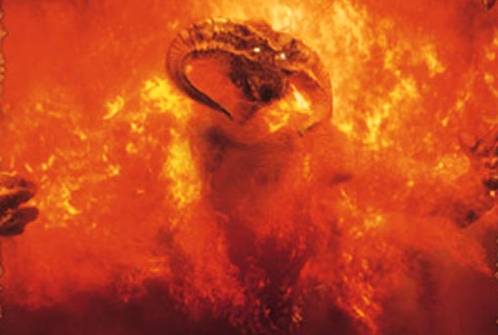
The Balrog is another evil creature and it is the carrier of fire and shadow. Once again we see a radical contrast at the centre of one of evilís creations. A foreground of fire and a background of shadow. The beast here relies on the impact of its visual form to instill fear. This impact is as potent as any weapon it carries. It has two aspects to petrify any invader. The shadow in its wake can freeze you in fear and the projecting fire, embodying much of the creature itself, can stir you in terror. The Balrog is a living son et lumiere of fear. The beast has gathered all available light as a fire which is marshalls all the more effectively by carrying its own shadowy backdrop. The wings spread out to create almost a stage backdrop for the fiery main show. The Balrog shows its two main aspect simultaneously: when the fire rages the face hardens and darkens. Fire and shadow displayed together. The face of the Balrog has some revealing aspects:
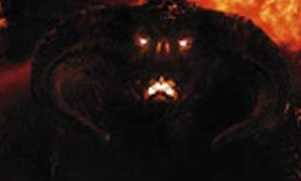
The dark face indeed has a mask like quality. In myth we often find that figures that embody or come from the realm of shadow wear masks. The horns of the beast remind us of the horns of a ram. The horns signal that the beast is an ancient one. This devil with horns from the ram has been revealed in old testament writings and it evokes ancient tidings of the 'mark of the beast.' We might think of Aries, a fire sign of astrological origin or the macabre renditions of the ram in the symbology of devil worship. We could also draw another inference alongside this new rendition of an older devilry. In biblical reference the ram is also a sacrificial beast. Rams have a habit of getting caught in thickets, captured and sacrificed. Maybe if the Balrog can be ensnared in some way and ultimately sacrificed it may have some transforming power. Th fire behind the mask itself has a whiter quality than the rest of the flaming beast. Maybe this is a white light.

For now though these are speculations. The beast is coming nearer. The Balrog is a theatrical beast.
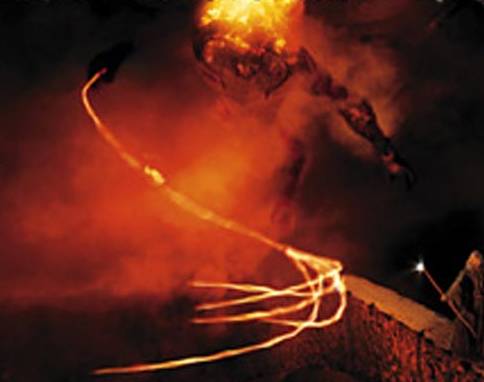
Itís size and fire are its visual tour de force but it also relies on buidup. It signals its coming with a drumbeat, stepping rhythmically our way as a herald of its coming. This is devilry. Evil loves its performance. The grand entrance of the Balrog is apre a fiery pre show where shadow and flame mix in a gruesome prologue. Then, announcements over, in comes the big show. Full display. We are going down. We wonder how to tackle a Balrog. Its notoriety precedes it and the prepublicity speaks of short odds. The creature has set the agenda, chosen the battleground and looks up for a fight. If we take the terms of battle offered we would surely be destroyed. Our first defence is the realisation that this creature is also a Guardian. It Guards a threshold and if we could get close enough we could cast it back there or discover the secret all this theatre is meant to distract us from. The Balrog wants to project its weapons at a distance, fiery plumes, fiery sword and whip can cut us down. We must transform this battle into an ordeal. Gandalf achieves this by standing ground. The encounter is therefore modified into an ordeal which has the possibility if not of victory then of some form of transformation. Confronted with steadfastness our Balrog has lost round one. Mutterings from Gandalf about secret flames and the waving staff have distracted it. It has not terrorised us and we seem to have some sort of open ended strategy. Our drumbeat is aryhtmical and disrupting. This will confuse the monodirectional Balrog.
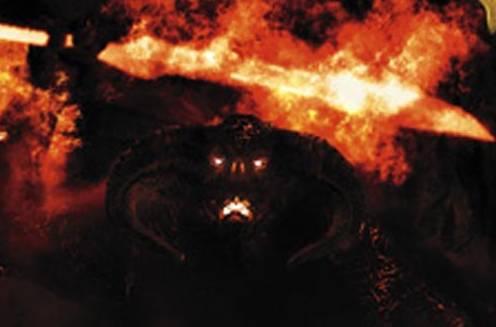
Why do we want to draw out the Balrog? The beast is not all devil. This shadow is not all black. By confronting the shadow and the fire Gandalf receives some of the positive qualities from a creature that at first seems to have none. See how Gandalf already is starting to transform, he seems to carry a tinge of white. There is a light from this fire, a white light and it portends a change in our mentor wizard. Wizardry here is defined as penetrating the shadow and drawing out qualities which it contains further using them in the service of sacred magic. This theme is further empahasised by the fact that the ordeal is happening on a bridge. In Fellowship bridges often signify a threshold, a bridge between worlds. The bridge of Khazad Dum also signigies an inner ordeal for Ganfalf. Gandalf is going to cross an inner threshold and change his aspect. He is going on an inner journey from grey to white. The element that will forge this change is fire.
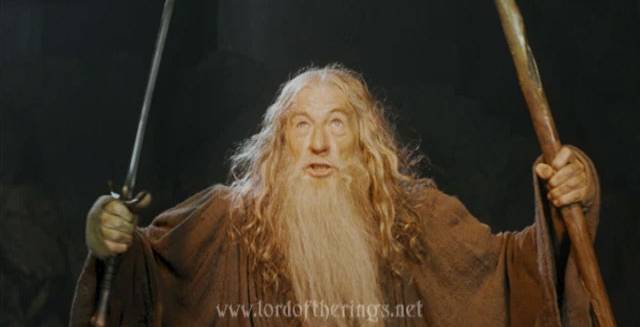 The Balrog is a colossus. A creature that relies on size and display backed up by mighty power. There is a parallel to Goya's amazing picture of the Colossus (below). The creature in Goya's picture is also large and demonical but its not clear whether it's destroying or guarding the people beneath it. The depiction of colossus hints at a possible positive element to the giant. The Balrog too is one large creature but with multiple aspects. The blackness in it speaks of the shadow we have found in the wraiths, the face is mask like which again portends the disguising aspect of a shadow being. With its weaponry it also signals that it is a threshold guardian. Gandalf will cross the threshold by reconfiguring the encounter at Khazad Dum from battle to personal ordeal. The ordeal will result in Gandalf's resurrection and transformation. Some of the power of the risen wizard will come from the fire of the Balrog, transformed by the ordeal into a purified white. We are witnessing the meeting of two mighty powers. The outcome will ultimately favour the wizard who will turn the fire to an alchemical use to transform himself. Fire can then become white light through the depths of the ordeal. Once again we see that evil can be used as an agent of transformation if we can hold still enough, long enough and face our own inner ordeal. The way beyond evil is through it.
|